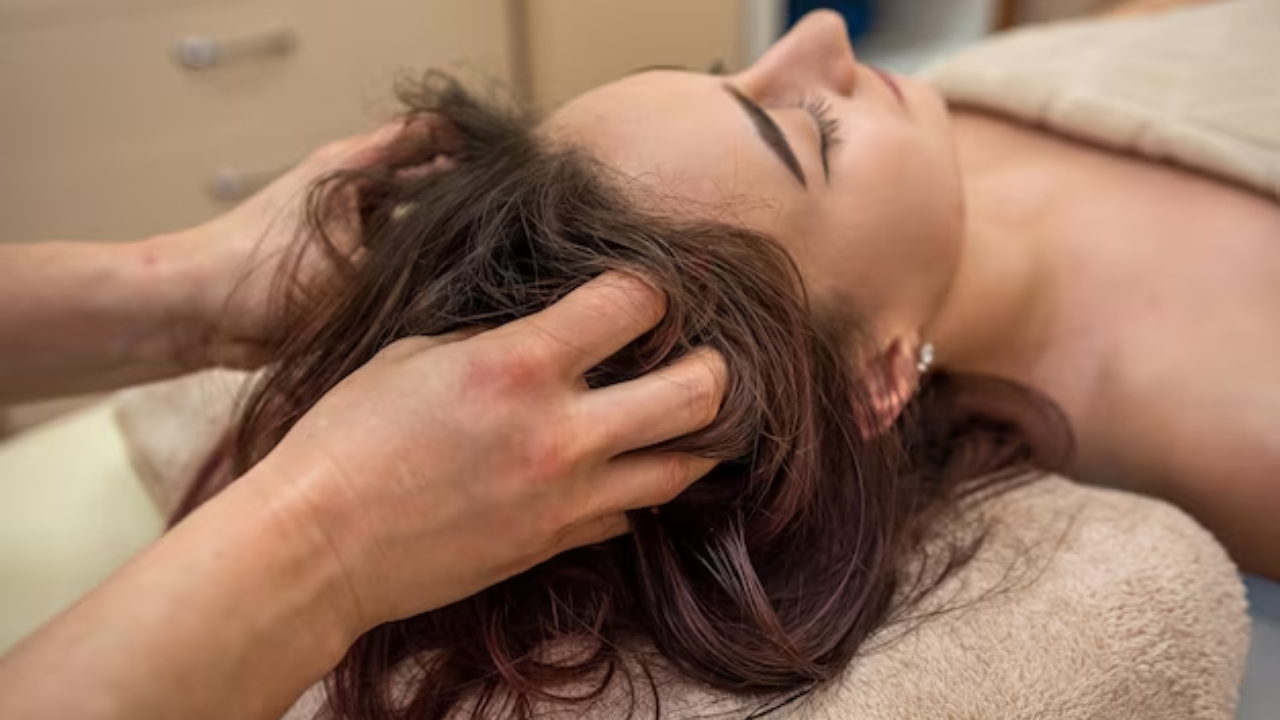- Health Conditions A-Z
- Health & Wellness
- Nutrition
- Fitness
- Health News
- Ayurveda
- Videos
- Medicine A-Z
- Parenting
- Web Stories
The Secret Behind Correct Oiling: When and How to Do It

Oiling your hair properly (Credit-Freepik)
Oiling your hair has been a cornerstone of hair care for centuries. It's a simple yet effective method to nourish, strengthen, and add a unique shine to your hair. But when and how should you do it for maximum benefit? We talk about the art and science of hair oiling, providing expert tips and guidance to help you achieve healthier, happier hair.
Many people abroad have also started including oiling in their daily hair care routines and seen phenomenal changes in their hair health. But you cannot make a half-hearted attempt to oil your hair; you must put in the effort to see changes. Here is the correct way of oiling and how to do it for the best results.
When to apply
Oiling our hair ensures that your hair is moisturized and healthy. Shampoos make your hair frizzy and dry, therefore you oil your hair before you shampoo. Oil your hair twice every week for the best results.
Scalp massage
A gentle scalp massage is beneficial for hair health. Using the tips of your fingers, apply circular motions to stimulate blood flow. This can encourage hair growth and relaxation. However, avoid vigorous rubbing to prevent hair breakage. Focus on the scalp, and be cautious not to tangle the hair.

Oil application
Whether you prefer wet or dry hair, it's crucial to start with clean hair for optimal oil absorption. Heavier oils might penetrate better on dry hair. Warming the oil can enhance its absorption. The quantity of oil depends on hair length, thickness, and the oil's viscosity. Apply sparingly to the scalp and distribute through the lengths and ends for moisture.
Oil treatment duration
The optimal duration for leaving oil on your hair is typically between one and two hours. While some individuals prefer overnight treatments, this isn’t always necessary. Excessive oil can lead to dryness and require more shampoo, which can be counterproductive. It's essential to use oil sparingly, as a small amount is often sufficient. While daily oiling is a common practice in some cultures, experts recommend limiting it to once or twice a week for optimal results.
How to apply hair oil
To effectively apply hair oil, begin by warming it gently if solid. Divide your hair into sections and massage the oil into your scalp and hair, from roots to tips. Use a wide-tooth comb to ensure even distribution. Once fully coated, gather your hair into a loose bun to avoid excessive tension. For deeper penetration, consider a warm shower or applying a hot towel to your head. When washing, shampoo thoroughly to remove all oil residue.
Common Allergy Medications Risk Outweigh The Benefits, Why Experts Say It's Time To Rethink Its Use

Credits: Canva
Sneezing? Have a cold? Wheezing because of pollen? Take a cetirizine! This is what we do and have continued to do since so long, but, it may be now the time that we stop.
Diphenhydramine, a first-generation antihistamine approved in 1946, has long held a place in medicine cabinets worldwide. Commonly used to treat everything from seasonal allergies to bug bites, it also appears in nighttime cold medications and over-the-counter sleep aids. However, according to a recent review by allergy experts from Johns Hopkins University and the University of California, San Diego, it’s time to move on.
The study, published earlier this year, emphasized that while diphenhydramine does offer symptom relief, it comes with a host of potentially dangerous side effects, especially when safer, second-generation antihistamines like cetirizine, loratadine, and fexofenadine are readily available.
Dr. Anna Wolfson, an allergist at Massachusetts General Hospital, said she sees the medication misused in clinical settings far too often. “If someone has an allergic reaction to food, people will say, ‘Don’t worry, I have diphenhydramine in my purse,’ but really, epinephrine is the first-line treatment,” she noted. The sedative effect of the drug can actually mask worsening symptoms, putting patients in more danger. So if you thought sleeping it off helps, maybe not?
The Hidden Dangers: Sedation, Cognitive Impairment and Misuse
The review also highlighted how diphenhydramine interacts with the brain, often causing drowsiness, confusion, cognitive impairment, and even cardiac complications. These effects are more pronounced in older adults, where the drug’s effects can linger for up to 18 hours, leading to falls and disorientation.
In children, misuse has resulted in hospitalizations, paradoxical hyperactivity, and even fatalities, some tied to the viral and deadly “Benadryl Challenge” on TikTok.
The medication was also found to have no substantial clinical advantage over newer antihistamines in randomized trials. While it may reduce sneezing and itching, it offers minimal benefit for nasal congestion and often comes with more side effects.
Expert Insights on Tighter Oversight
Dr. Siri Kamath, a consultant in internal medicine at Gleneagles BGS Hospital in Bengaluru, agrees with the growing global consensus. “Diphenhydramine is an older antihistamine, and while it works, the safety cushion is thinner now, especially when anyone can buy it over the counter,” she said.
Dr. Kamath explains that while the drug can still be useful in emergencies, such as anaphylactic reactions when paired with epinephrine or in managing motion sickness and certain neurological conditions, its use in routine allergy management is unnecessary and potentially harmful.
She adds that regulatory bodies in India, such as the Central Drugs Standard Control Organization (CDSCO) and the Indian Pharmacopoeia Commission (IPC), monitor drug safety through real-world data. “When a drug begins doing more damage than healing, especially with safer choices available, it sparks a fresh look from regulators,” she notes.
Misuse Is a Key Part of the Problem
Diphenhydramine’s accessibility without prescription has made it susceptible to misuse. Dr. Kamath says it’s not just the drug’s inherent properties, but also the lack of awareness among the public and the way it’s marketed. “Clearer labels, more thoughtful dispensing by pharmacists, and public awareness can go a long way in preventing misuse,” she said. “We can’t overlook troubling trends online. This medicine does its job when used right, but without proper checks, its easy access can turn into a silent danger.”
This sentiment is echoed by American pharmacists and pediatricians who report that the medication is often misused in children for sleep and cold symptoms, despite its limited efficacy and serious risks. Saline drops, suctioning, or second-generation antihistamines like cetirizine are now preferred options for children above six months.
The Case for Moving Diphenhydramine Behind the Counter
Globally, experts are now calling for diphenhydramine to be either removed from the over-the-counter market or moved behind the counter to ensure pharmacist oversight.
In India, Dr. Kamath suggests tighter regulation rather than a blanket ban. “Instead of a full ban, we need better communication and tighter dispensing rules,” she said.
The Consumer Healthcare Products Association, which represents manufacturers like Benadryl's maker Kenvue, maintains that the medication is safe when used as directed and already includes clear warning labels. However, with over 1.5 million prescriptions still written annually in the U.S. alone, and countless untracked OTC purchases worldwide, some experts believe more than warning labels may be needed.
Balancing Familiarity with Evidence
For many patients and families, diphenhydramine is a go-to remedy that evokes familiarity and trust. But Dr. Kamath cautions against letting that history cloud present risks. “So many patients hold on to older medicines not out of defiance, but because they’ve leaned on them for years. But familiarity should never come at the cost of safety.”
India Achieves Third Rank Globally With 18,900 Organ Transplants In 2024– What To Expect When You Pledge To Donate Organs

(Credit-Canva)
Organ donation is a selfless way to give back to one’s community and a great way to look out for those who are in need, even after you pass on. This has been growing sentiment all over the world and India has shown massive growth in the sector. The Ministry of Health and Family Welfare announced the milestone achievement of India completing more than 18,900 organ transplants, the most ever in a single year. This is a big jump from fewer than 5,000 transplants in 2013.
Because of this effort, India is now third in the world for organ transplants, just behind the United States and China. Union Health Minister Shri Jagat Prakash Nadda spoke at the 15th Indian Organ Donation Day ceremony, he also noted that India is a world leader in hand transplants, showing the high skill of its surgeons.
What Helped The Rise In Numbers of Donations?
The government is working hard to make organ donation easier for everyone. Since a new online pledge website was launched in 2023, over 3.30 lakh people have signed up to donate their organs. This shows that more and more citizens are willing to help.
To support this, the government is improving hospitals and training more staff to make sure organs can be moved quickly and safely. They also provide financial help of up to ₹15 lakh for poor patients needing a transplant and cover kidney transplants under the Ayushman Bharat PM-JAY health plan.
What To Expect When You Pledge To Donate Organs
Organ donation can save lives, and there are two main ways to do it. According to All India Institute of Medical Science (AIIMS) you can choose to be a donor while you are alive, or your family can give their permission after you pass away. The Organ Retrieval Banking Organization (ORBO) helps coordinate this entire process. If you want to donate your organs after you die, you can pledge to be a donor now. Here’s how it works:
Fill out a form: You can get a free donor form from ORBO's website or by contacting them directly.
Get it signed: You need to fill out the form and have it signed by two witnesses, one of whom should be a close family member.
Send it in: Mail the completed form back to ORBO.
Receive your card: ORBO will send you a donor card with a registration number.
Tell your family: It’s important to keep your donor card with you and tell your family about your decision. This helps make sure your wishes are known.
Can Anyone Donate Organs?
The Kerala State Organ and Tissue Transplant Organization (K-SOTTO) explains that generally, anyone can donate organs or tissues, regardless of age. People with conditions like cancer or HIV are typically not able to donate, but even these rules can be flexible in certain situations. Before any organs are used, doctors will run tests to make sure they are healthy and won't pass on any diseases. The final decision on whether an organ is suitable for donation is made by doctors at the time of death.
Informing Your Family Is Important
K-SOTTO states that in India, the most important step for an organ donor is to talk with their family. Your donor card is not a legal document; it only shows your wish. By law, organ donation can only happen if your family gives written permission. That's why it's crucial to tell your family about your decision. Explain why it matters to you so they will be more likely to honor your wishes if the time comes.
Organ Donation After Death
AIIMS adds to the previous point and explains that even if a person did not register as an organ donor, their family can still choose to donate their organs after their death. The family simply needs to sign a consent form, and the organs are then quickly and respectfully removed within a few hours. The Organ Retrieval Banking Organization (ORBO) team manages this entire process, ensuring that the body is returned to the family in a dignified manner with no disfigurement. This allows funeral arrangements to proceed as normal.
Pledging your organs is simply the first step towards the donation process, having open conversations and necessary dialogues with your family, health care professionals will ensure the process happens smoothly.
71-Year-Old Declared Dead, But Came Back Alive: How Science Explains This Shocking Revival

(Credit-Canva)
As we grow old, it is said that our balance and stability decreases, and the chances of us falling and injuring ourselves is much more prevalent. It was just another day in the emergency room when a 71-year-old was admitted after cranial and thoracic trauma from a fall. He was a bit confused and struggling to catch his breath, but the team was optimistic. They began the standard workup, expecting to stabilize him for further evaluation.

However, the treatment was derailed when he suddenly experienced a cardiorespiratory arrest. The emergency room staff-initiated CPR, following the strict protocols of Advanced Life Support. They checked for cardiac tamponade, a potential cause, but the bedside ultrasound showed nothing. Despite receiving CPR for 20 minutes, his heart didn't respond. He was declared dead. About one minute later, however, his heart began beating on its own, and he ‘rose from the dead’. He still couldn't breathe on his own and was moved to the ICU.
Also Read: Loni Anderson Dies Day Before Her 80th Birthday: Remembering Her Crusade Against COPD
Although he was stabilized, the man eventually died. His injuries included bleeding in the brain, fractures to his skull, neck, and ribs. This report was published in the International Journal of Innovative Research in Medical Science, detailing a case of Lazarus phenomenon that happened in February of 2025.
Rising From the Dead – Not A Miracle But Medical Phenomenon
When an emergency situation arises and we must rush to the doctors, they try their level best to ensure that the person receiving the care survives and has the best possible quality of life. However, it is not always possible. So, it is nothing short of a miracle when a person comes back to life, after some period of being declared dead. This is called the Lazarus Syndrome. It is a rare event where a person's heart spontaneously starts beating again after they've been pronounced dead following a failed CPR attempt, it was named after the biblical figure Lazarus.
The International Journal of Community Medicine and Public Health 2024 review explains that even though it has been documented in medical literature, doctors don't fully understand why the Lazarus syndrome happens. Several theories have been proposed. Sometimes, the drugs given during CPR might not work right away. The heart could restart when the medication finally takes effect. Some possible theories suggested by the:
Delayed Medication Effect
Sometimes, drugs given during CPR might not work right away. The heart could restart when the medication finally takes effect.
Hyperkalemia
An excess of potassium in the bloodstream may play a role.
Myocardial Stunning
This refers to a temporary loss of heart function that can improve on its own.
Reperfusion Injury
When blood flow returns to the heart after a period of being stopped, it can sometimes cause further damage.
Is It Medical Negligence Or An Unavoidable Phenomenon?
To understand this, a 2012 survey published in the Critical Care Medicine, asked doctors what methods they used to declare a patient dead. Out of 501 intensive care doctors in Canada, 49% responded to a survey about how they determine death after a patient's heart stops. The doctors had an average of 10 years of experience and typically worked in large, university-affiliated hospitals.
The survey revealed a lot of variation in how doctors declare a patient dead. The most common methods were listening for heart and breath sounds and checking for a pulse, but no single method was used by everyone. Despite the variations, many doctors agreed on a few key points:
Lazarus Phenomenon
65% of the doctors believe that autoresuscitation, or the Lazarus phenomenon, is real, with 37% saying they have personally seen a possible case during their career.
Need for Guidelines
A large majority of doctors (69%) believe there needs to be a standardized process for declaring death after a cardiac arrest. This number was even higher (91%) when it came to cases involving organ donation.
How Does The Lazarus Phenomenon Change Medical Care?
The 2024 review of Lazarus syndrome details how the syndrome forces us to rethink what it means to be alive or dead. It raises difficult questions, such as:
- When is someone really dead? It makes doctors re-examine the rules for declaring death.
- What about organ donation? If a patient could potentially come back to life, it complicates the process of organ donation.
- What if they survive with brain damage? Doctors and families must consider the patient's potential quality of life if they recover but have suffered brain injury.
How Do the Doctors Deal With Lazarus Syndrome?
To understand the effects of Lazarus syndrome, the medical team’s main goal is to figure out what caused it and to give the appropriate treatment. They might use advanced cardiac life support, which means giving the highest level of care possible.
Doctors might also use a special machine called extracorporeal membrane oxygenation (ECMO) to help the heart and lungs work.
Another treatment option is therapeutic hypothermia, where the patient's body is cooled down to help protect their brain from damage.
Ultimately, we still have a lot to learn about this rare event, and more research is needed to better understand how to manage it.
© 2024 Bennett, Coleman & Company Limited

